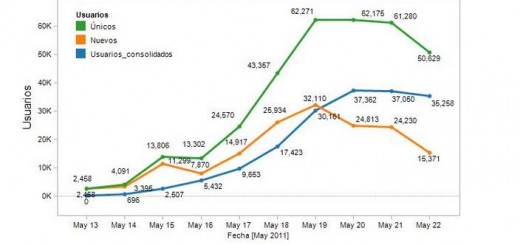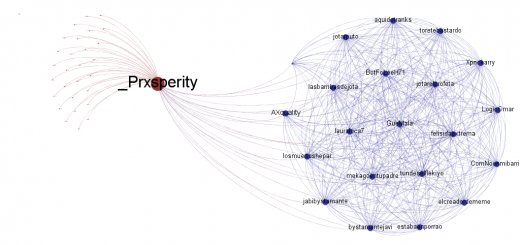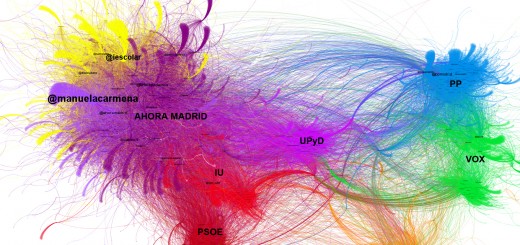Viralidad en Twitter: TweetMatrioskaViral on Twitter: TweetMatrioska
Propagación espacio/temporal de una curiosa cadena de tweets encapsulados unos dentro de otros. Al experimento le he llamado TweetMatrioska porque al igual que las tradicionales muñecas rusas, un tweet encerraba un tweet que a su vez contenía otro tweet y así sucesivamente hasta llegar al tweet origen. (El mapa está realizado con CartoBD con el wizard de Torque. Una auténtica maravilla por lo potente y sencillo de usar) Todo empezó el día 14 de febrero cuando me enteré de esta cadena por @estebanmoro y @moebio. Buscando el origen encontré que el causante, @BenHowe, no sin antes examinar casi 40 tweets.
This is how a curious chain of tweets encapsulated within each other was spread in space and time. I have called this experiment TweetMatrioska because as traditional Russian dolls, a tweet contained a tweet which inside contained another tweet and so on until the tweet source. (The map is made with CartoBD, the wizard used was Torque. A true wonder so powerful and easy to use) It all began on February 14 when I found this chain by @estebanmoro and @moebio. Seeking the source I found the origin, @BenHowe, not without examining nearly 40 tweets before. This experiment aroused my curiosity because it is closely related to my research on propagation and I quickly got to attempt recovery of tweets from this chain. I found this solution but I wanted to analyze this dynamic diffusion with my own resources and these are the first results of the experiment. Propagation network topology
- Number of nodes: 10,568
- Number of connections between nodes (multiple connections between nodes are counted as one): 11,170
- Network diameter : 70 ( the largest chain nested tweets was 70! )
- Average chain length : 20,54
- Clustering coefficient : 0.006
Temporal propagation The following timeline represents the number of tweets/hour ( GMT) during the propagation.
To get the data I have followed this methodology:
- Find the tweet source from my chain ( 38 links)
- From the tweet source obtain by search API what tweets included the URL into the tweet and by a recursive manner get the chain of tweets. I found 11,339 tweets from 10,568 different users. By this method I did not acquire all tweets (I did not get elements from my chain). This could be due to two reasons:
- The search API does not provide all the messages asked
- If the URL of the tweet is encapsulated with an URL shortener as bitly or owly, is not found when looking for the tweet as https://twitter.com/screen_name/status/xxxxxxxxxxxxx
- Generate a graph with an ad hoc script for this type of propagation
- Find the geographic coordinates of the locations declared in the user’s profile with the Google Maps API (has a rate limit of 2,500 per day). The coordinates of the 70 % of users were obtained
Este experimento despertó mi curiosidad ya que tiene mucha relación con mi investigación sobre propagación y me puse rápidamente a intentar recuperar los tweets de esta cadena. Encontré esta solución pero quise analizar esta dinámica de difusión con mis propios medios y estos son los primeros resultados del experimento Topología de red de propagación
- Número de nodos: 10.568
- Número de conexiones entre los nodos (las conexiones múltiples entre nodos se cuentan como una) : 11.170
- Diámetro de la red: 70 (la cadena mayor fue de 70 tweets anidados!!)
- Longitud media de las cadenas: 20,54
- Coeficiente de clustering: 0,006
Propagación Temporal El siguiente timeline representa el número de tweets/hora (hora GMT) durante el periodo de propagación.
Para obtener los datos he seguido la siguiente metodología:
- Buscar el origen del tweet desde mi cadena (con 38 eslabones)
- Partiendo del tweet origen obtener con search API los tweets que incluían la URL del tweet origen de una forma recursiva. Se encontraron 11.339 tweets de 10.568 usuarios distintos. No conseguí por este método todos los tweets (no encontré elementos de mi cadena). Esto ha podido deberse a dos motivos
- El search API no proporciona todos los mensajes consultados
- Si la URL del tweet se encapsula con un acortador tipo bitly o owly (se usa una app de escritorio) no se encuentra cuando se busca el tweet como https://twitter.com/screen_name/status/xxxxxxxxxxxx
- Generar el grafo de propagación con un script ad hoc para este tipo de propagación
- Buscar las coordenadas geográficas de las localizaciones declaradas en el perfil del usuario con el API de Google Maps (tiene un rate limit de 2.500 al día). Se obtuvieron las coordenadas del 70% de los usuarios



